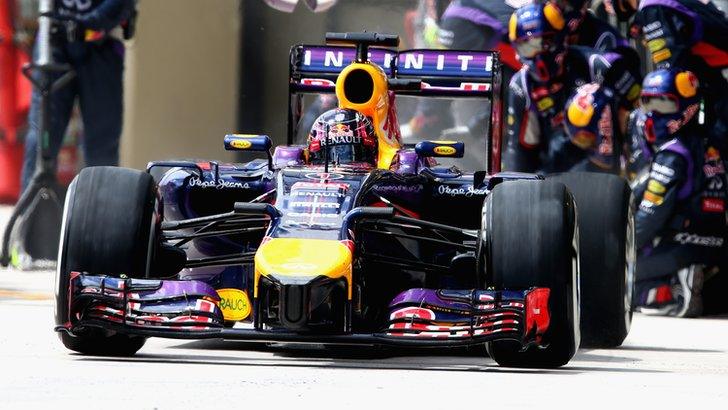Honda's F1 return seemingly soured with engine controversy
- Published
- comments
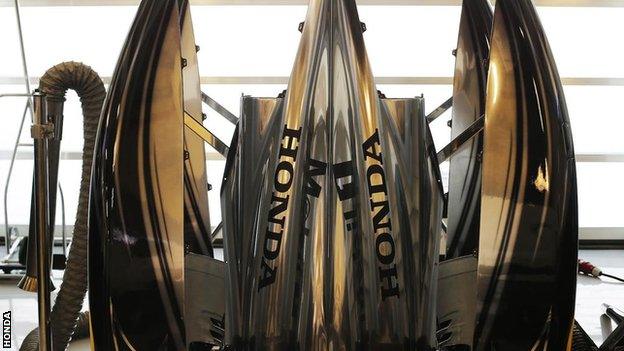
Honda has teamed-up with McLaren again, having powered Ayrton Senna to all of his world championships
Honda are still two months away from the first race of their high-profile new partnership with McLaren but already the Japanese company is at the heart of a controversy in Formula 1.
A U-turn on an interpretation of a complex engine rule has led to the Japanese company questioning whether it is being treated fairly on its return to F1 after a six-year absence.
It is a typically complicated and arcane issue, but it could have an impact on the competitiveness of the car to be driven by the all-star line-up of Fernando Alonso and Jenson Button.
What has happened?
F1 started a new era of turbo hybrid engines, and an accompanying restriction on fuel, in 2014. The power units are remarkable pieces of cutting-edge technology featuring levels of thermal efficiency better than a road-going diesel, and, as a result, very expensive. So to keep costs down, the plan was to limit development.
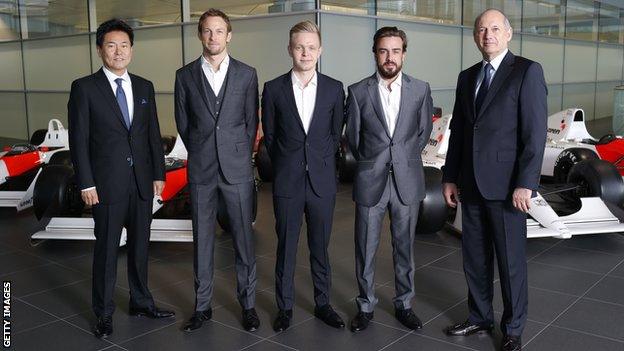
Fernando Alonso (second from right) and Jenson Button (second from left) will line-up for McLaren next season
A complicated set of rules was devised whereby in-season development would be banned, but manufacturers could make limited improvements between seasons. The amount they could change was laid out in the rules, and reduced from year to year.
The entire engine design was split into 66 'tokens', representing parts and allocated according to their influence on performance.
Manufacturers could change a maximum of 32 tokens for 2015, 26 for 2016 and so on, on a sliding scale to almost nothing in 2019 and 2020.
The plan was that any manufacturer who entered F1 after 2014 would start from the same place and be governed by the same restrictions.
That would mean that Honda would be treated in its first season in 2015 in the same way as the others were in 2014.
As often happens in F1, however, the intention of the rules was not clearly expressed in the way they were written. And that has left a loophole that some are trying to exploit to their own competitive advantage.
Who has interfered and why?
As soon as it became clear in 2014 that Mercedes had a significant performance advantage over their rivals, Renault and Ferrari began pushing to be allowed more freedom to make changes to their engines.
These soon focused on the desire to develop them during the 2015 season, largely because both manufacturers realised they would not be able to make all the changes they wanted in time for 28 February 2015.
Engine development - the detail |
|---|
Complex turbo hybrid engines were introduced in 2014 |
Development rules follow a formula that defines 92% of the engine as being open to development from the first season of the design to the second |
From this, manufacturers choose a maximum of 48% they can develop |
This 48% is split into 32 'tokens', assigned to parts of the engine depending on their influence on performance |
Following the latest FIA rule clarification, manufacturers in their second season are now able to implement their 32 development tokens over the course of the year, rather than having to do so before the season starts |
They all knew that was the planned date by which the final engine design had to be submitted to the FIA for homologation, after which the specification would be frozen other than for changes for reliability, cost-saving or fuel efficiency reasons.
But Ferrari, who had the worst engine in 2014 and were the most behind in their developments for 2015, discovered that although the FIA had been clear about the 28 February deadline in communications with the teams, it was not specified in the rules for 2015, only for 2014.
They pointed this out to race director Charlie Whiting in a meeting at the end of last season.
Whiting was initially of the belief that his interpretation should hold, but when his clarification on the situation was later sent around to the teams, the FIA had accepted that Ferrari had a point.
The new opinion from the FIA was that Mercedes, Renault and Ferrari could apply their 32 development tokens over the course of the 2015 season. Honda, as a new manufacturer and without a homologated engine of any description, had no tokens to apply as it did not have a 2014 engine to apply them to.
Does this put Honda at a disadvantage?
A senior figure at one of the existing manufacturers says that it "won't make much of a difference". But a) he would say that, wouldn't he? and b) that in itself is a tacit admission that it will make a difference; the question is how much.
Another expert says: "Honda were probably already at a disadvantage because they have had to develop the engine with no testing and will not have had a chance to run much before homologation.

Jenson Button previously drove for the Honda works team
"But the additional degree of freedom for the other manufacturers is a second- or third-order effect on performance."
Honda, sources say, disagree with that. The Japanese company has kept its counsel publicly so far, saying only that it "believes in fair competition for the goodness of the sport and our fans". But it's clear even from that statement that Honda believes the current situation is not equitable.
Its rivals, of course, would argue that Honda did start with an advantage, in that while the other manufacturers were shooting in the dark, as soon as the 2014 engines began to run, Honda knew what it was aiming for.
Additionally, there are now suppliers out there with parts Honda can buy off the shelf, should they wish, whereas when the other manufacturers were developing their engines there were not.
But that does not alter the basic fact that, as things stand at the moment, Mercedes, Renault and Ferrari will be able to develop their engines during the 2015 season and Honda will not.
Is the FIA's position consistent?
The logic is clear. Mercedes, Renault and Ferrari are not being allowed to do any more to their engines than they were before, they are just being given longer to do it.
Honda, meanwhile, has no choice but to submit its engine before the season as it is not possible to race without a homologated design. It is being held back no more than the others were last year, and the rules as far as it is concerned have remained the same.
However, there are potential problems surrounding the current interpretation:
1) While the rules for Honda are the same as before, those governing the other three have now changed.
2) Mercedes, Renault and Ferrari all homologated 2014 engine designs and have 32 tokens to apply. But as soon as any of those tokens are applied, the engine is technically not the same any more and therefore strictly speaking not homologated. So at what point does it become a 2015 engine?
The FIA's current thinking is that at any point between zero and 32 tokens being applied, the engine is homologated. The engines change anyway during the season, on the basis of the modifications that are allowed in terms of cost-saving and so on, so there is never a single spec of a given engine. This new situation is, logically, no different, the FIA would argue.
3) There are two important ways in which Honda has more restrictions on it than its rivals did in 2014. Last year, the rules said each driver could only use five engines; any more and there were stringent penalties. This year, that number has been reduced to four. For everyone, including Honda.
So although Honda is being treated as if it was in its first season in terms of being banned from doing in-season development, it is being held to the same restrictions in terms of engine usage as other manufacturers. That is despite Mercedes, Ferrari and Renault having a year's experience of using the engines which Honda does not have.
And while Honda is not being allowed to use 32 tokens this year, nor will it next year. In 2016, it will be restricted to 26 tokens, the same as everybody else.
The FIA's position is that those are the rules and Honda knew what they were before it entered - and that the regulations governing development and number of engines are separate.
But it's not hard to see how some could question whether that was fair and consistent.
What happens next?
Honda top brass are meeting the FIA on Monday to discuss their concerns over this issue.
For now, the FIA feels it has come up with the best possible compromise.
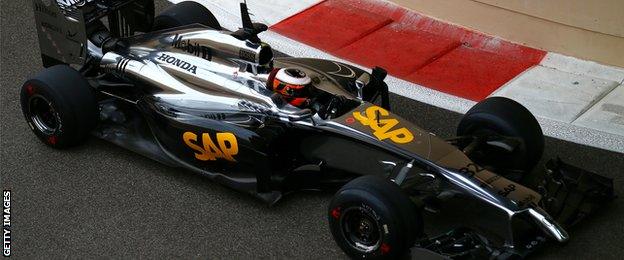
McLaren will have had only limited running with its new Honda engine before the 2015 season
However, it will point out to Honda that the clarification issued on this is only an opinion, and can be challenged, either by the stewards at a race meeting or at the FIA court of appeal.
That is not normally Honda's style - it prefers to take a low-key approach.
But Honda is unhappy, and fans of the sport have already taken to social media to question the fairness of this situation.
Somehow or other, this row will have to come to a resolution, and F1 is not there yet.
- Published7 January 2015

- Published11 January 2015
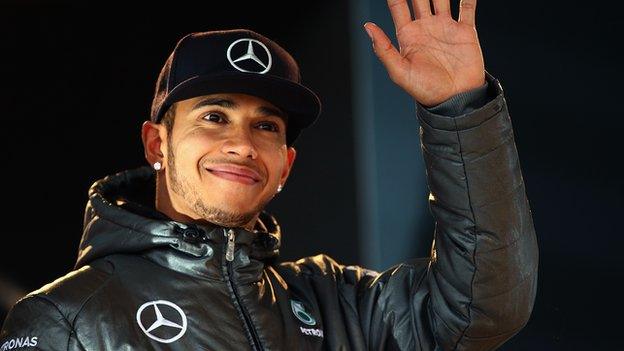
- Published29 December 2014
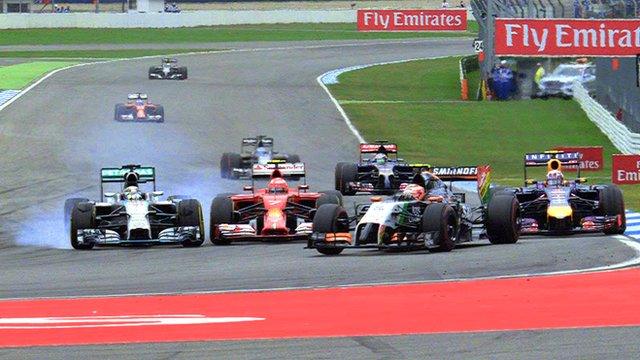
- Published5 January 2015
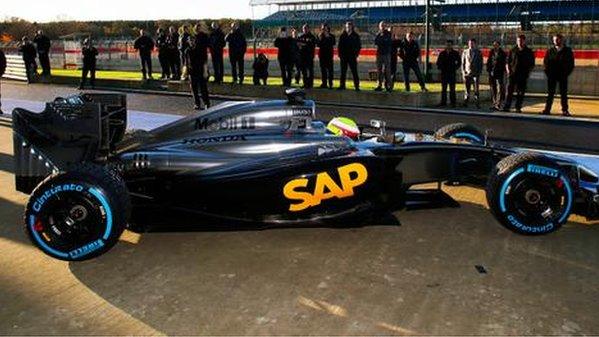
- Published29 November 2014
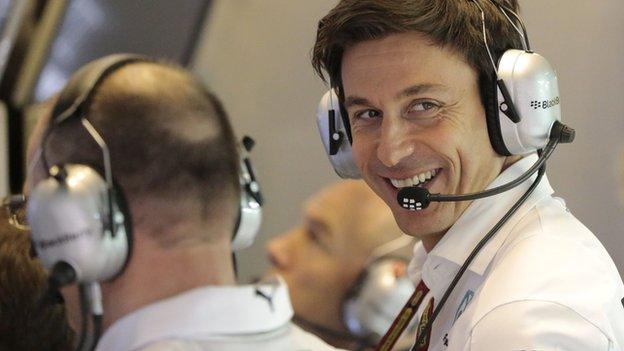
- Published21 November 2014

- Published13 November 2014
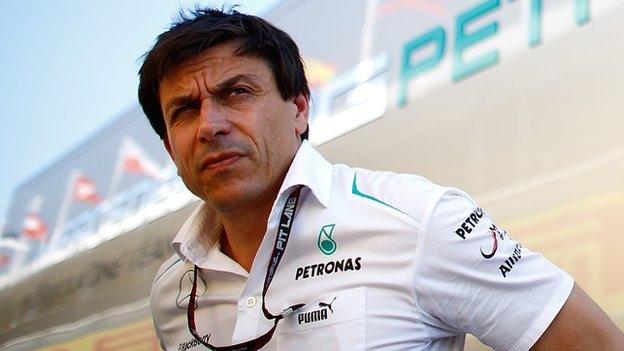
- Published10 November 2014
